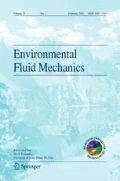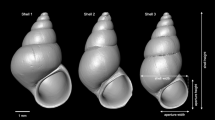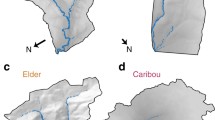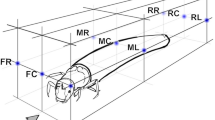Abstract
Spatially averaged velocity distributions, turbulence characteristics, and stream bed roughness elevations were collected in two streams with rough-bed substrate. Variogram analysis of substrate roughness height yielded characteristic length scales of the stream bed over which bed elevations were correlated from 0.14 to 0.41 m. Temporally and spatially averaged (double-averaged) vertical velocity profiles followed a composite distribution consisting of a linear distribution below the roughness crest height and a power or wake law above the crest. Our double-averaged velocity data demonstrated the applicability of both the wake law and power law to open-channel flow for which a low ratio of flow depth to roughness height does not support the development of the universal logarithmic velocity law. A power-law scaling relationship among spatially averaged Glossosoma density, stream bed roughness characteristics, and double-averaged fluid flow conditions was developed. The density of Glossosoma scaled directly with substrate crest elevation, normalized spatial fluctuation of longitudinal velocity in the proximity of the bed, and inversely with the standard deviation of the crest elevation. The proposed dimensionless scaling relationship explains 84 % of the Glossosoma variability.












Similar content being viewed by others
Abbreviations
- \(\alpha \) :
-
Exponent in the power law distribution
- \(\upbeta \) :
-
A parameter in the exponential distribution (1/m)
- \(\text{ C}_\mathrm{p}\) :
-
Parameter for the power law distribution
- \(\text{ C}_\mathrm{w}\) :
-
Parameter for the wake law distribution
- \(\Delta \) :
-
Distance to sill of variogram indicating characteristic length scale of the variable in question (m); subscripts x and y indicates longitudinal and transverse directions, respectively
- \(\text{ Fr}=\left\langle \text{ u} \right\rangle _\mathrm{vol} /\sqrt{g\left\langle \text{ H} \right\rangle }\) :
-
Froude number
- \(g\) :
-
Gravitational constant
- \(\text{ G}_\mathrm{density}\) :
-
Glossosoma spatial density on the stream bed \((\text{ no./m}^{2})\)
- \(\text{ G}_\mathrm{mass}\) :
-
Glossosoma spatial density, expressed in biomass, on the stream bed \((\text{ g/m}^{2})\)
- \(\text{ H}\) :
-
Maximum flow depth (m) from free surface to roughness troughs within the boundaries of a window defined for spatial averaging
- \(\text{ I}_{\tilde{\mathrm{u}}} ={\left\langle {\tilde{\text{ u}}} \right\rangle _\mathrm{mb}}/{\left\langle \text{ u} \right\rangle _\mathrm{c}}\) :
-
The spatial velocity fluctuation at the mean-bed elevation normalized by double-averaged velocity at the crest
- \(\upphi =\frac{\text{ A}_\mathrm{f} }{\text{ A}_\mathrm{o}}\) :
-
Roughness geometry function = area of fluid/total spatial averaging area
- \(\upphi _{\mathrm{int}} =\int \limits _{\mathrm{z}_\mathrm{t}}^{\mathrm{z}_\mathrm{c}} \upphi \text{ dz}\) :
-
Integral of the roughness geometry function in the interfacial sublayer
- \(l_\mathrm{c}\) :
-
Shear length scale characterizing flow dynamics within the roughness layer (m) [1, 33]
- \(\kappa \) :
-
Von Karman’s constant = 0.41
- \(\upmu \) :
-
Dynamic viscosity (kg/(ms))
- \(\nu \) :
-
Kinematic viscosity \((\text{ m}^{2}/\text{ s})\)
- \(\Pi \) :
-
Coles wake strength parameter
- \(\text{ Q}=\text{ A}\left\langle \text{ u}\right\rangle _\mathrm{vol}\) :
-
Bulk discharge \((\text{ m}^{3}/\text{ s})\), where A = cross-sectional area
- \(\text{ Re}={\left\langle \text{ u}\right\rangle _\mathrm{vol} \left\langle \text{ H} \right\rangle }/\nu \) :
-
Reynolds number; a ratio of inertial to viscous forces in the flow
- \(\text{ Re}_{*}=0.5\text{ z}_\mathrm{c} \left\langle {\text{ u}_{*}} \right\rangle /\nu \) :
-
Roughness Reynolds number where \(\text{ z}_\mathrm{c}\) takes the place of substrate grain diameter
- \(\upsigma _{\mathrm{z}_\mathrm{k}}\) :
-
Standard deviation of the roughness heights of each grid cell within a spatial averaging window (m)
- \(\left\langle \text{ U}\right\rangle _\mathrm{vol}\) :
-
Bulk velocity, i.e. triple averaged velocity magnitude: temporally-, horizontally-, then depth-averaged (m/s)
- \(\text{ u}, \text{ v}, \text{ w}\) :
-
Longitudinal, transverse, and vertical velocity components, respectively (m/s)
- \(\text{ u}_\mathrm{rms}\) :
-
Root mean square of the temporal velocity fluctuations (m/s)
- \(\left\langle {\text{ u}_{*}} \right\rangle =\left\langle {\left( \overline{\text{ u}^{\prime }\text{ w}^{\prime }}^{2}+\overline{\text{ v}^{\prime }\text{ w}^{\prime }}^{2} \right)^{0.25}} \right\rangle _\mathrm{c}\) :
-
Shear velocity; the spatially averaged measure of total vertical flux of horizontal momentum (see Stull [47, p. 67]). In this study this is evaluated at or extrapolated to \(\text{ z}_\mathrm{c}\) (m/s)
- \(\left\langle \text{ u}\right\rangle _\mathrm{c}\) :
-
Spatially averaged velocity at the elevation of \(\text{ z}_\mathrm{c}\) (m/s)
- \(\left\langle \text{ u}\right\rangle _\mathrm{mb}\) :
-
Spatially averaged velocity at the elevation of \(\text{ z}_\mathrm{mb}\) (m/s)
- \(\left\langle \text{ u}\right\rangle _\mathrm{PIV}\) :
-
Spatially averaged velocity magnitude estimated from surface particle image velocimetry (PIV) (m/s)
- \(\tilde{\text{ u}}\) :
-
Tilde denotes a spatial fluctuation of a time averaged flow variable; in this case it is the difference between \(\bar{\text{ u}}\) at each point within a spatial-averaging window and \(\left\langle {\bar{\text{ u}}} \right\rangle \), where \(\bar{\text{ u}}\) is the time-average of \(\text{ u}\) (m/s)
- \(\text{ z}\) :
-
Height above \(\text{ z}_\mathrm{t}\) (m)
- \(\text{ z}_\mathrm{c}\) :
-
Maximum \(\text{ z}_\mathrm{k}\) within a spatial averaging window (m)
- \(\text{ z}_\mathrm{k}\) :
-
Bed roughness height; the distance from the roughness peak to the roughness trough within a spatial averaging window grid cell (m)
- \(\text{ z}_\mathrm{mb} =\text{ z}_\mathrm{c} -\int \limits _{\mathrm{z}_\mathrm{c}}^{\mathrm{z}_\mathrm{t}} \upphi \text{ dz}\) :
-
Mean bed elevation following Nikora et al. [5]
- \(\text{ z}_\mathrm{r}\) :
-
Upper boundary of the roughness layer
- \(\text{ z}_\mathrm{t}\) :
-
Trough elevation, or the minimum roughness elevation within an averaging window (m)
References
Nikora V, McLean S, Coleman S, Pokrajac D, McEwan I, Campbell L, Aberle J, Clunie D, Kol K (2007) Double-averaging concept for rough-bed open-channel and overland flows: applications. J Hydraul Eng 133(8):884–895. doi:10.1061/(ASCE)0733-9429(2007)133:8(884)
Martino R, Paterson A, Piva M (2012) Double-average mean flow and local turbulence intensity profiles from PIV measurements for an open channel flow with rigid vegetation. Environ Fluid Mech 12(1):45–62. doi:10.1007/s10652-011-9221-4
Nikora V, McEwan I, McLean S, Coleman S, Pokrajac D, Walters R (2007) Double-averaging concept for rough-bed open-channel and overland flows: theoretical background. J Hydraul Eng 133(8):873–883. doi:10.1061/(ASCE)0733-9429(2007)133:8(873)
Sarkar S, Dey S (2010) Double-averaging turbulence characteristics in flows over a gravel bed. J Hydraul Res 48(6):801–809. doi:10.1080/00221686.2010.526764
Nikora V, Goring D, McEwan I, Griffiths G (2001) Spatially averaged open-channel flow over rough bed. J Hydraul Eng 127(2):123–133
Manes C, Pokrajac D, McEwan I (2007) Double-averaged open-channel flows with small relative submergence. J Hydraul Eng 133(8):896–904. doi:10.1061/(ASCE)0733-9429(2007)133:8(896)
Coleman S, Nikora V, McLean S, Schlicke E (2007) Spatially averaged turbulent flow over square ribs. J Eng Mech 133:194
Mignot E, Barthelemy E, Hurther D (2009) Double-averaging analysis and local flow characterization of near-bed turbulence in gravel-bed channel flows. J Fluid Mech 618:279–303
Nikora V (2010) Hydrodynamics of aquatic ecosystems: an interface between ecology, biomechanics and environmental fluid mechanics. River Res Appl 26(4):367–384. doi:10.1002/rra.1291
Dey S, Sarkar S, Ballio F (2011) Double-averaging turbulence characteristics in seeping rough-bed streams. J Geophys Res 116:F03020. doi:10.1029/2010JF001832
Gore JA, Layzer JB, Mead J (2001) Macroinvertebrate instream flow studies after 20 years: a role in stream management and restoration. Regul Rivers: Res Manag 17(4–5):527–542
Hart DD, Clark BD, Jasentuliyana A (1996) Fine-scale field measurement of benthic flow environments inhabited by stream invertebrates. Limnol Oceanogr 41(2):297–308
Koll K (2006) Parameterisation of the vertical velocity profile in the wall region over rough surfaces. In: Proceedings of the international conference on fluvial hydraulics, Lisbon, 6–8 Sept 2006
Pokrajac D, Finnigan JJ, Manes C, McEwan I, Nikora V (2006) On the definition of the shear velocity in rough bed open channel flows. In: Proceedings of the international conference on fluvial hydraulics. River flow, Lisbon, Sept 2006, pp 6–8
Nezu I, Nakagawa H (1993) Turbulence in open-channel flows. IAHR/AIRH Monograph, pp 215–224
Nikora V, Koll K, McEwan I, McLean S, Dittrich A (2004) Velocity distribution in the roughness layer of rough-bed flows. J Hydraul Eng 130(10):1036–1042. doi:10.1061/(ASCE)0733-9429(2004)130:10(1036)
Jimenez J (2004) Turbulent flows over rough walls. Annu Rev Fluid Mech 36:173–196. doi:10.1146/annurev.fluid.36.050802.122103
Katul G, Wiberg P, Albertson J, Hornberger G (2002) A mixing layer theory for flow resistance in shallow streams. Water Resour Res 38(11):1250
Coleman SE, Nikora VI, McLean SR, Clunie TM, Schlicke T, Melville BW (2006) Equilibrium hydrodynamics concept for developing dunes. Phys Fluids 18(10):105104-1–105104-12. doi:10.1063/1.2358332
McNeely C, Power ME (2007) Spatial variation in caddisfly grazing regimes within a northern California watershed. Ecology 88(10):2609–2619
Barbour MT, Gerritsen J, Snyder BD, Stribling JB (1999) Rapid bioassessment protocols for use in streams and wadeable rivers: periphyton, benthic macroinvertebrates and fish, 2nd edn. U. S. Environmental Protection Agency, Office of Water, Washington, DC, 841-B-99-002
Bouchard RWJ (2004) Guide to aquatic macroinvertebrates of the Upper Midwest. Water Resources Center, University of Minnesota, St. Paul
MacArthur RH (1972) Geographical ecology: patterns in the distribution of species. Princeton University Press, Princeton
Paine RT (1980) Food webs—linkage, interaction strength and community infrastructure—the 3rd Tansley lecture. J Anim Ecol 49(3):667–685
Kohler SL, Wiley MJ (1992) Parasite-induced collapse of populations of a dominant grazer in Michigan streams. Oikos 65(3):443–449
Kohler SL, Wiley MJ (1997) Pathogen outbreaks reveal large-scale effects of competition in stream communities. Ecology 78(7):2164–2176
Morris MWL, Hondzo M, Power ME (2011) Scaling Glossosoma (Trichoptera) density by abiotic variables in mountain streams. J N Am Benthol Soc 30(2):493–506
Nikora V, Goring D, Biggs B (1998) On gravel-bed roughness characterization. Water Resour Res 34(3):517–527
Parsheh M, Sotiropoulos F, Porte-Agel F (2010) Estimation of power spectra of acoustic-Doppler velocimetry data contaminated with intermittent spikes. J Hydraul Eng 136(6):368–378
Noss C, Salzmann T, Storchenegger I (2010) Turbulent and advective momentum fluxes in streams. Water Resour Res 46:W12518. doi:10.1029/2010WR009297
Roy A, Biron P, DeSerres B (1996) On the necessity of applying a rotation to instantaneous velocity measurements in river flows. Earth Surf Process Landf 21(9):817–827. doi:10.1002/(SICI)1096-9837(199609)21:9<817:AID-ESP618>3.0.CO;2-4
Raupach MR, Thom AS (1981) Turbulence in and above plant canopies. Annu Rev Fluid Mech 13:97–129. doi:10.1146/annurev.fl.13.010181.000525
Raupach M, Finnigan J, Brunet Y (1996) Coherent eddies and turbulence in vegetation canopies: the mixing-layer analogy. Bound-Layer Meteorol 78(3–4):351–382. doi:10.1007/BF00120941
Gad-el-Hak M, Buschmann MH (2011) Turbulent boundary layers: is the wall falling or merely wobbling? Acta Mech 218(3–4):309–318. doi:10.1007/s00707-010-0429-z
Cameron SM, Nikora VI, Coleman SE (2008) Double-averaged velocity and stress distributions for hydraulically-smooth and transitionally-rough turbulent flows. Acta Geophys 56(3):642–653. doi:10.2478/s11600-008-0028-8
Flack KA, Schultz MP, Rose WB (2012) The onset of roughness effects in the transitionally rough regime. Int J Heat Fluid Flow 35:160–167. doi:10.1016/j.ijheatfluidflow.2012.02.003
Vaschy A (1892) Sur les lois de similitude en physique. Ann Télégr 19:25–28
Buckingham E (1914) On physically similar systems; illustrations of the use of dimensional equations. Phys Rev 4(4):345–376
Cionco RM (1978) Analysis of canopy index values for various canopy densities. Bound-Layer Meteorol 15(1):81–93
Barenblatt GI (2003) Scaling, vol 34. Cambridge University Press, Cambridge
Barenblatt GI, Prostokishin VM (1993) Scaling laws for fully developed turbulent shear flows. Part 2. Processing of experimental data. J Fluid Mech 248:521–529
Izakson A (1937) On the formula for the velocity distribution near walls. Tech Phys USSR 2(4):155–162
Coles D (1956) The law of the wake in the turbulent boundary layer. J Fluid Mech 1(02):191–226
Hinze JO (1975) Turbulence, 2nd edn. McGraw-Hill, New York
Nikora VI, McLean SR (2001) Environmental flows over tough beds: a spatial averaging approach. In: Proceedings of the 3rd international symposium on environmental hydraulics, Tempe
MacVicar BJ, Rennie CD (2012) Flow and turbulence redistribution in a straight artificial pool. Water Resour Res 48:W02503
Stull RB (1988) An introduction to boundary layer meteorology. Kluwer, Dordrecht
Brodkey R, Hershey H (1988) Transport phenomena: a unified approach. McGraw-Hill, New York
Kundu P, Cohen I (2008) Fluid mechanics, vol 4. Elsevier, San Diego
Garcia X-F, Schnauder I, Pusch MT (2012) Complex hydromorphology of meanders can support benthic invertebrate diversity in rivers. Hydrobiologia 685(1):49–68. doi:10.1007/s10750-011-0905-z
George WK (2006) Recent advancements toward the understanding of turbulent boundary layers. AIAA J 44(11):2435–2449. doi:10.2514/1.19951
George WK, Castillo L (1997) Zero-pressure-gradient turbulent boundary layer. Appl Mech Rev 50(11):689–729
Buschmann MH, Gad-El-Hak M (2003) Generalized logarithmic law and its consequences. AIAA J 41(1):40–48. doi:10.2514/2.1911
Lancaster J, Downes BJ (2010) Linking the hydraulic world of individual organisms to ecological processes: putting ecology into ecohydraulics. River Res Appl 26(4):385–403. doi:10.1002/rra.1274
Okano J, Kikuchi E (2012) Effect of current velocity and case adaptations on the distribution of caddisfly larvae (Glossosoma, Trichoptera). Limnology 13(1):37–43. doi:10.1007/s10201-011-0353-5
Rameshwaran P, Naden PS, Lawless M (2011) Flow modelling in gravel-bed rivers: rethinking the bottom boundary condition RID D-2041-2010. Earth Surf Process Landf 36(10):1350–1366. doi:10.1002/esp.2158
Acknowledgments
This work was supported by the National Science Foundation under grant IGERT: Nonequilibrium Dynamics Across Space and Time: A Common Approach for Engineers, Earth Scientists, and Ecologists (Grant Number DGE-0504195), as well as the National Center for Earth-surface Dynamics (NCED), a Science and Technology Center funded by the office of Integrative Activities of the National Science Foundation (under Agreement Number EAR-0120914). We thank the University of California Natural Reserve System and the Steel family for providing access to streams in the Angelo Coast Range Reserve, and the Belwin Conservancy for providing access to Valley Creek in Minnesota. The authors are grateful to Dr. V. Nikora, University of Aberdeen, for encouragement to integrate the abundance of Glossosoma with double-averaged hydraulic variables.
Author information
Authors and Affiliations
Corresponding author
Rights and permissions
About this article
Cite this article
Morris, M.W.L., Hondzo, M. Double-averaged rough-bed open-channel flow with high Glossosoma (Trichoptera: Glossosomatidae) abundance. Environ Fluid Mech 13, 257–278 (2013). https://doi.org/10.1007/s10652-012-9265-0
Received:
Accepted:
Published:
Issue Date:
DOI: https://doi.org/10.1007/s10652-012-9265-0




